Premature decay and failure of building materials: a condition report
VerifiedAdded on 2021/06/14
|15
|3952
|209
AI Summary
Condition Report 1 CONSTRUCTION ECOLOGY: CONDITION REPORT Name Course Professor University Melbourne City/state Date EXECUTIVE SUMMARY This condition report presents a comprehensive analysis of three scenarios of building materials: two scenarios where building materials (efflorescence and concrete spalling) deteriorated and failed prematurely and one scenario where a building material (glass) performed exceptionally. In the first scenario, efflorescence occurred due to poor quality of cement and sand, poor workmanship of the tile installer and use of acids to
Contribute Materials
Your contribution can guide someone’s learning journey. Share your
documents today.
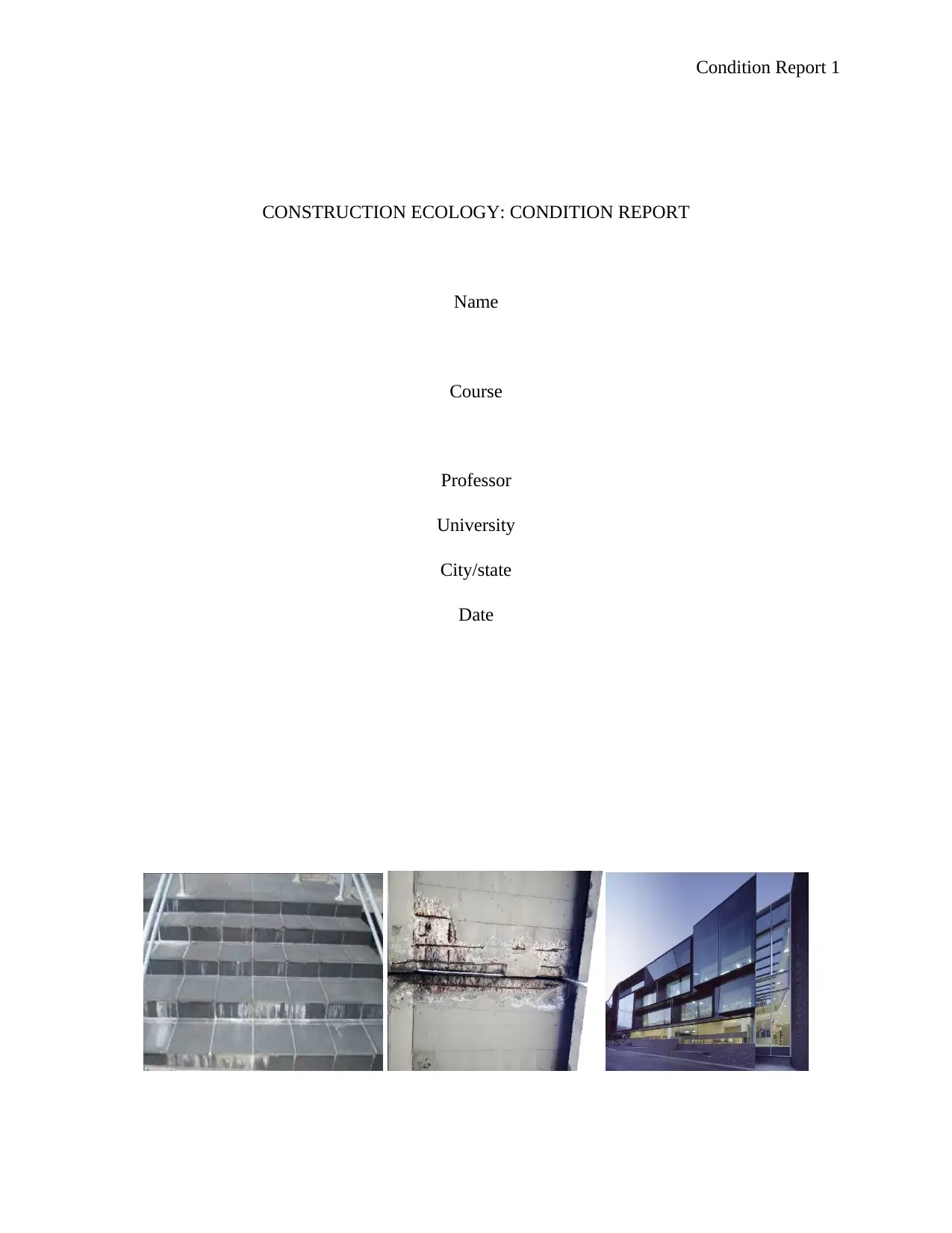
Condition Report 1
CONSTRUCTION ECOLOGY: CONDITION REPORT
Name
Course
Professor
University
City/state
Date
CONSTRUCTION ECOLOGY: CONDITION REPORT
Name
Course
Professor
University
City/state
Date
Secure Best Marks with AI Grader
Need help grading? Try our AI Grader for instant feedback on your assignments.
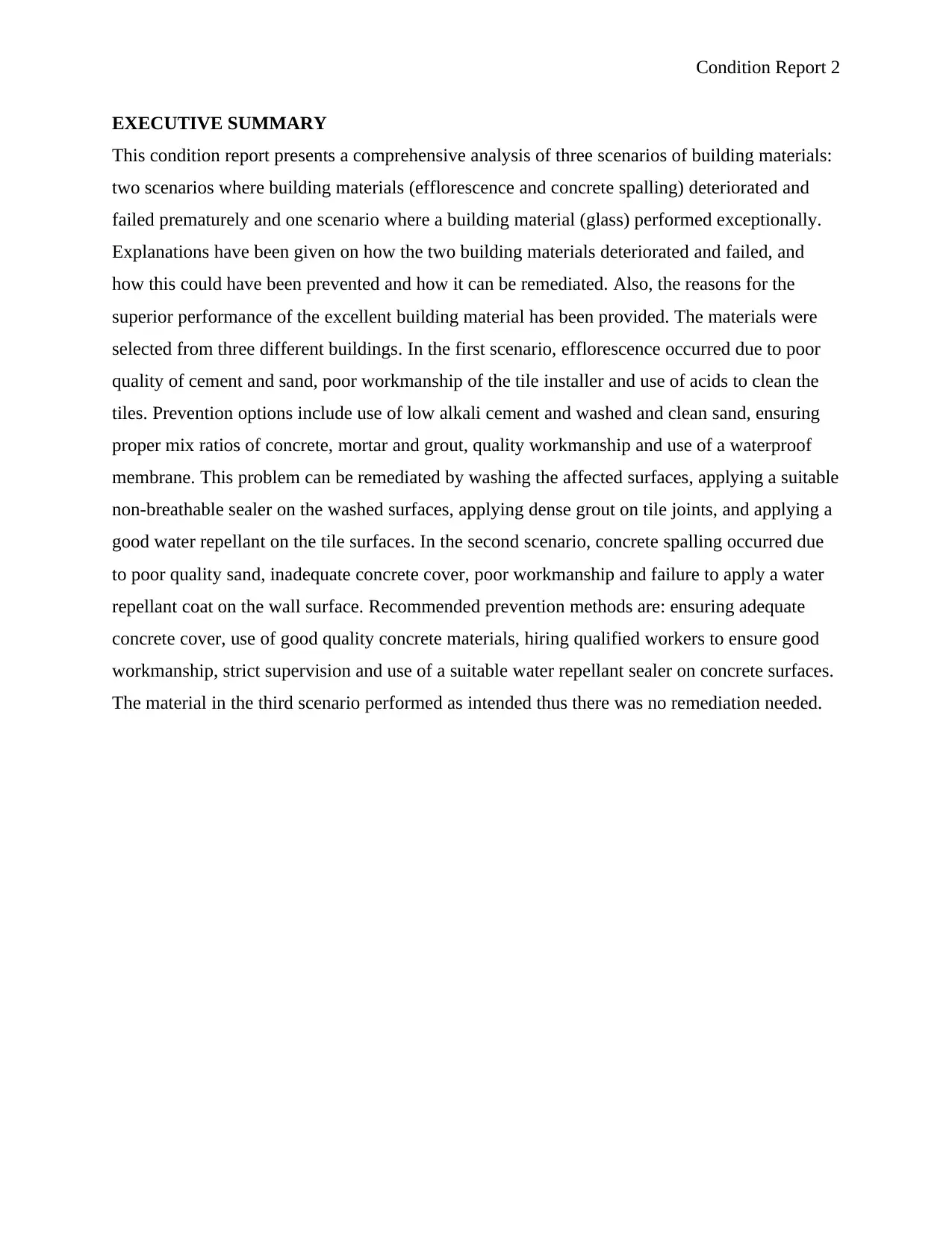
Condition Report 2
EXECUTIVE SUMMARY
This condition report presents a comprehensive analysis of three scenarios of building materials:
two scenarios where building materials (efflorescence and concrete spalling) deteriorated and
failed prematurely and one scenario where a building material (glass) performed exceptionally.
Explanations have been given on how the two building materials deteriorated and failed, and
how this could have been prevented and how it can be remediated. Also, the reasons for the
superior performance of the excellent building material has been provided. The materials were
selected from three different buildings. In the first scenario, efflorescence occurred due to poor
quality of cement and sand, poor workmanship of the tile installer and use of acids to clean the
tiles. Prevention options include use of low alkali cement and washed and clean sand, ensuring
proper mix ratios of concrete, mortar and grout, quality workmanship and use of a waterproof
membrane. This problem can be remediated by washing the affected surfaces, applying a suitable
non-breathable sealer on the washed surfaces, applying dense grout on tile joints, and applying a
good water repellant on the tile surfaces. In the second scenario, concrete spalling occurred due
to poor quality sand, inadequate concrete cover, poor workmanship and failure to apply a water
repellant coat on the wall surface. Recommended prevention methods are: ensuring adequate
concrete cover, use of good quality concrete materials, hiring qualified workers to ensure good
workmanship, strict supervision and use of a suitable water repellant sealer on concrete surfaces.
The material in the third scenario performed as intended thus there was no remediation needed.
EXECUTIVE SUMMARY
This condition report presents a comprehensive analysis of three scenarios of building materials:
two scenarios where building materials (efflorescence and concrete spalling) deteriorated and
failed prematurely and one scenario where a building material (glass) performed exceptionally.
Explanations have been given on how the two building materials deteriorated and failed, and
how this could have been prevented and how it can be remediated. Also, the reasons for the
superior performance of the excellent building material has been provided. The materials were
selected from three different buildings. In the first scenario, efflorescence occurred due to poor
quality of cement and sand, poor workmanship of the tile installer and use of acids to clean the
tiles. Prevention options include use of low alkali cement and washed and clean sand, ensuring
proper mix ratios of concrete, mortar and grout, quality workmanship and use of a waterproof
membrane. This problem can be remediated by washing the affected surfaces, applying a suitable
non-breathable sealer on the washed surfaces, applying dense grout on tile joints, and applying a
good water repellant on the tile surfaces. In the second scenario, concrete spalling occurred due
to poor quality sand, inadequate concrete cover, poor workmanship and failure to apply a water
repellant coat on the wall surface. Recommended prevention methods are: ensuring adequate
concrete cover, use of good quality concrete materials, hiring qualified workers to ensure good
workmanship, strict supervision and use of a suitable water repellant sealer on concrete surfaces.
The material in the third scenario performed as intended thus there was no remediation needed.
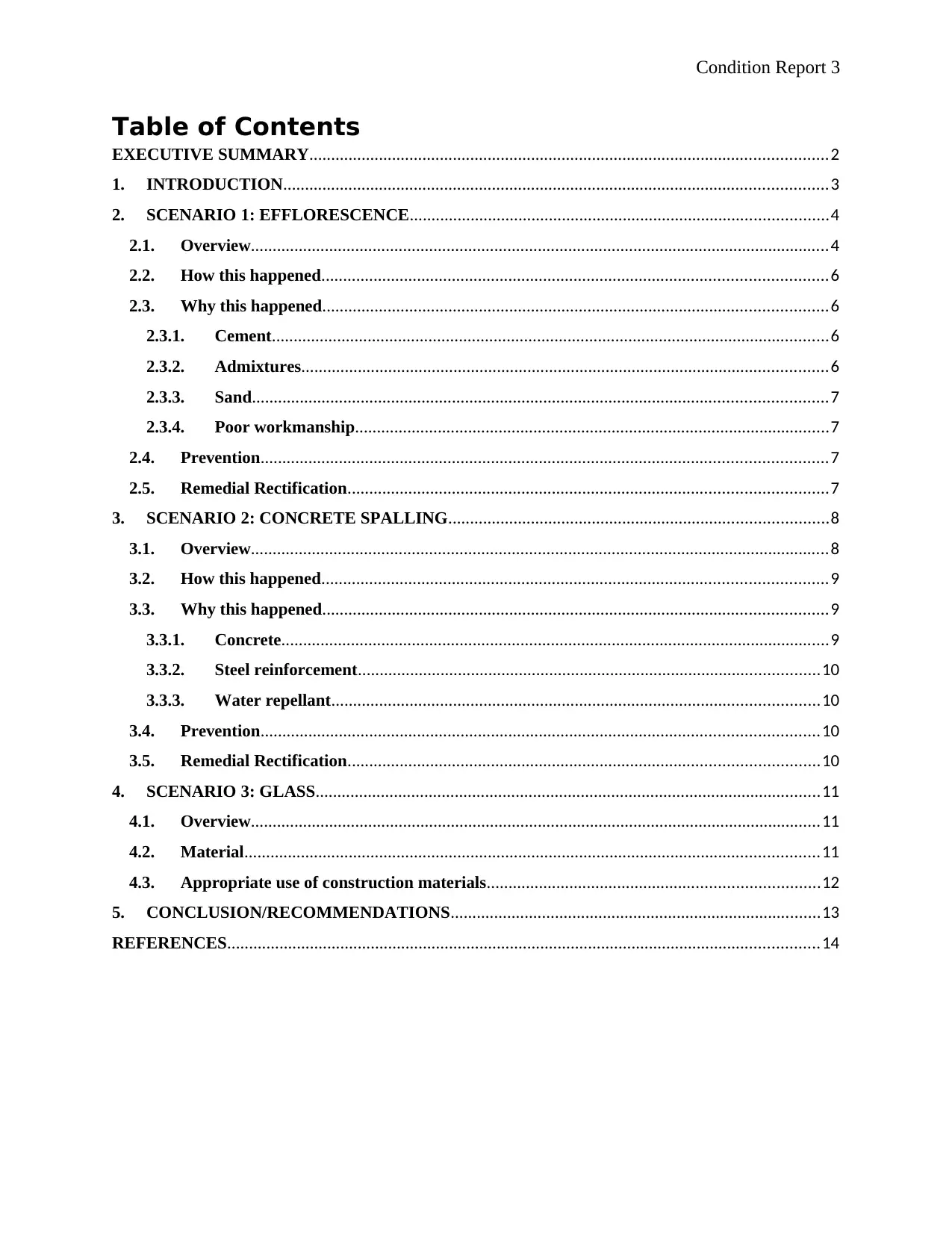
Condition Report 3
Table of Contents
EXECUTIVE SUMMARY.......................................................................................................................2
1. INTRODUCTION.............................................................................................................................3
2. SCENARIO 1: EFFLORESCENCE................................................................................................4
2.1. Overview.....................................................................................................................................4
2.2. How this happened....................................................................................................................6
2.3. Why this happened....................................................................................................................6
2.3.1. Cement................................................................................................................................6
2.3.2. Admixtures.........................................................................................................................6
2.3.3. Sand....................................................................................................................................7
2.3.4. Poor workmanship.............................................................................................................7
2.4. Prevention..................................................................................................................................7
2.5. Remedial Rectification..............................................................................................................7
3. SCENARIO 2: CONCRETE SPALLING.......................................................................................8
3.1. Overview.....................................................................................................................................8
3.2. How this happened....................................................................................................................9
3.3. Why this happened....................................................................................................................9
3.3.1. Concrete..............................................................................................................................9
3.3.2. Steel reinforcement..........................................................................................................10
3.3.3. Water repellant................................................................................................................10
3.4. Prevention................................................................................................................................10
3.5. Remedial Rectification............................................................................................................10
4. SCENARIO 3: GLASS....................................................................................................................11
4.1. Overview...................................................................................................................................11
4.2. Material....................................................................................................................................11
4.3. Appropriate use of construction materials............................................................................12
5. CONCLUSION/RECOMMENDATIONS.....................................................................................13
REFERENCES........................................................................................................................................14
Table of Contents
EXECUTIVE SUMMARY.......................................................................................................................2
1. INTRODUCTION.............................................................................................................................3
2. SCENARIO 1: EFFLORESCENCE................................................................................................4
2.1. Overview.....................................................................................................................................4
2.2. How this happened....................................................................................................................6
2.3. Why this happened....................................................................................................................6
2.3.1. Cement................................................................................................................................6
2.3.2. Admixtures.........................................................................................................................6
2.3.3. Sand....................................................................................................................................7
2.3.4. Poor workmanship.............................................................................................................7
2.4. Prevention..................................................................................................................................7
2.5. Remedial Rectification..............................................................................................................7
3. SCENARIO 2: CONCRETE SPALLING.......................................................................................8
3.1. Overview.....................................................................................................................................8
3.2. How this happened....................................................................................................................9
3.3. Why this happened....................................................................................................................9
3.3.1. Concrete..............................................................................................................................9
3.3.2. Steel reinforcement..........................................................................................................10
3.3.3. Water repellant................................................................................................................10
3.4. Prevention................................................................................................................................10
3.5. Remedial Rectification............................................................................................................10
4. SCENARIO 3: GLASS....................................................................................................................11
4.1. Overview...................................................................................................................................11
4.2. Material....................................................................................................................................11
4.3. Appropriate use of construction materials............................................................................12
5. CONCLUSION/RECOMMENDATIONS.....................................................................................13
REFERENCES........................................................................................................................................14
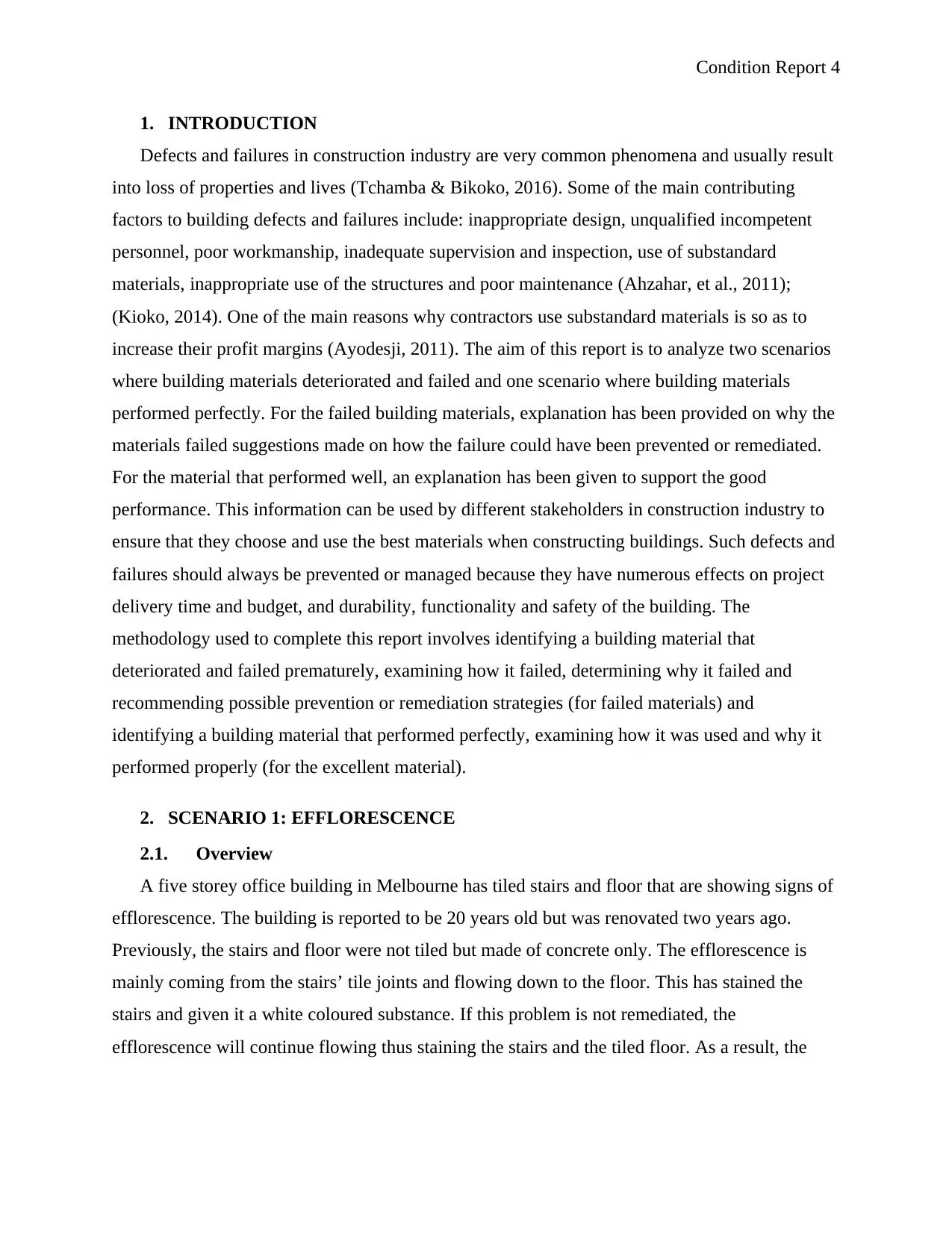
Condition Report 4
1. INTRODUCTION
Defects and failures in construction industry are very common phenomena and usually result
into loss of properties and lives (Tchamba & Bikoko, 2016). Some of the main contributing
factors to building defects and failures include: inappropriate design, unqualified incompetent
personnel, poor workmanship, inadequate supervision and inspection, use of substandard
materials, inappropriate use of the structures and poor maintenance (Ahzahar, et al., 2011);
(Kioko, 2014). One of the main reasons why contractors use substandard materials is so as to
increase their profit margins (Ayodesji, 2011). The aim of this report is to analyze two scenarios
where building materials deteriorated and failed and one scenario where building materials
performed perfectly. For the failed building materials, explanation has been provided on why the
materials failed suggestions made on how the failure could have been prevented or remediated.
For the material that performed well, an explanation has been given to support the good
performance. This information can be used by different stakeholders in construction industry to
ensure that they choose and use the best materials when constructing buildings. Such defects and
failures should always be prevented or managed because they have numerous effects on project
delivery time and budget, and durability, functionality and safety of the building. The
methodology used to complete this report involves identifying a building material that
deteriorated and failed prematurely, examining how it failed, determining why it failed and
recommending possible prevention or remediation strategies (for failed materials) and
identifying a building material that performed perfectly, examining how it was used and why it
performed properly (for the excellent material).
2. SCENARIO 1: EFFLORESCENCE
2.1. Overview
A five storey office building in Melbourne has tiled stairs and floor that are showing signs of
efflorescence. The building is reported to be 20 years old but was renovated two years ago.
Previously, the stairs and floor were not tiled but made of concrete only. The efflorescence is
mainly coming from the stairs’ tile joints and flowing down to the floor. This has stained the
stairs and given it a white coloured substance. If this problem is not remediated, the
efflorescence will continue flowing thus staining the stairs and the tiled floor. As a result, the
1. INTRODUCTION
Defects and failures in construction industry are very common phenomena and usually result
into loss of properties and lives (Tchamba & Bikoko, 2016). Some of the main contributing
factors to building defects and failures include: inappropriate design, unqualified incompetent
personnel, poor workmanship, inadequate supervision and inspection, use of substandard
materials, inappropriate use of the structures and poor maintenance (Ahzahar, et al., 2011);
(Kioko, 2014). One of the main reasons why contractors use substandard materials is so as to
increase their profit margins (Ayodesji, 2011). The aim of this report is to analyze two scenarios
where building materials deteriorated and failed and one scenario where building materials
performed perfectly. For the failed building materials, explanation has been provided on why the
materials failed suggestions made on how the failure could have been prevented or remediated.
For the material that performed well, an explanation has been given to support the good
performance. This information can be used by different stakeholders in construction industry to
ensure that they choose and use the best materials when constructing buildings. Such defects and
failures should always be prevented or managed because they have numerous effects on project
delivery time and budget, and durability, functionality and safety of the building. The
methodology used to complete this report involves identifying a building material that
deteriorated and failed prematurely, examining how it failed, determining why it failed and
recommending possible prevention or remediation strategies (for failed materials) and
identifying a building material that performed perfectly, examining how it was used and why it
performed properly (for the excellent material).
2. SCENARIO 1: EFFLORESCENCE
2.1. Overview
A five storey office building in Melbourne has tiled stairs and floor that are showing signs of
efflorescence. The building is reported to be 20 years old but was renovated two years ago.
Previously, the stairs and floor were not tiled but made of concrete only. The efflorescence is
mainly coming from the stairs’ tile joints and flowing down to the floor. This has stained the
stairs and given it a white coloured substance. If this problem is not remediated, the
efflorescence will continue flowing thus staining the stairs and the tiled floor. As a result, the
Secure Best Marks with AI Grader
Need help grading? Try our AI Grader for instant feedback on your assignments.
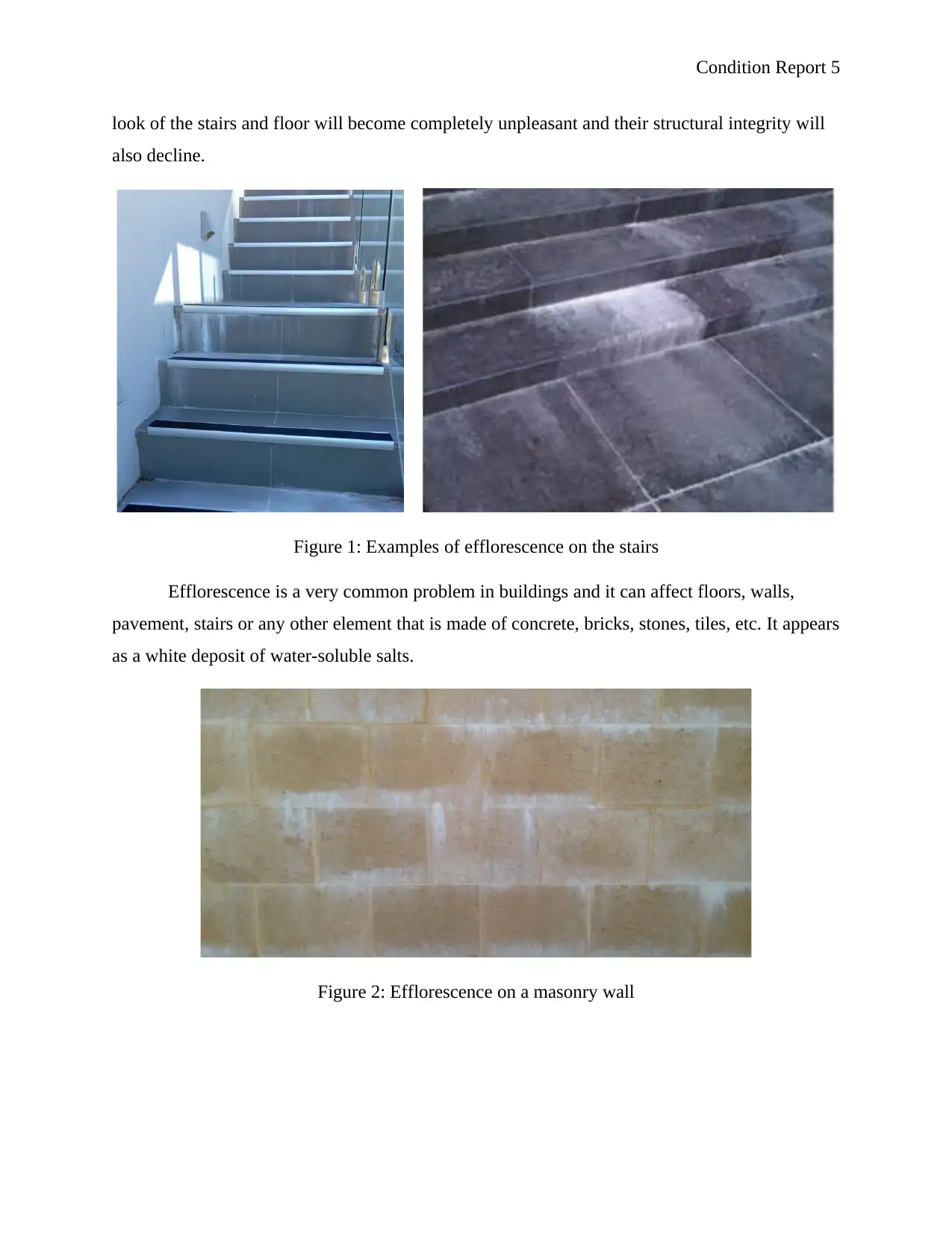
Condition Report 5
look of the stairs and floor will become completely unpleasant and their structural integrity will
also decline.
Figure 1: Examples of efflorescence on the stairs
Efflorescence is a very common problem in buildings and it can affect floors, walls,
pavement, stairs or any other element that is made of concrete, bricks, stones, tiles, etc. It appears
as a white deposit of water-soluble salts.
Figure 2: Efflorescence on a masonry wall
look of the stairs and floor will become completely unpleasant and their structural integrity will
also decline.
Figure 1: Examples of efflorescence on the stairs
Efflorescence is a very common problem in buildings and it can affect floors, walls,
pavement, stairs or any other element that is made of concrete, bricks, stones, tiles, etc. It appears
as a white deposit of water-soluble salts.
Figure 2: Efflorescence on a masonry wall
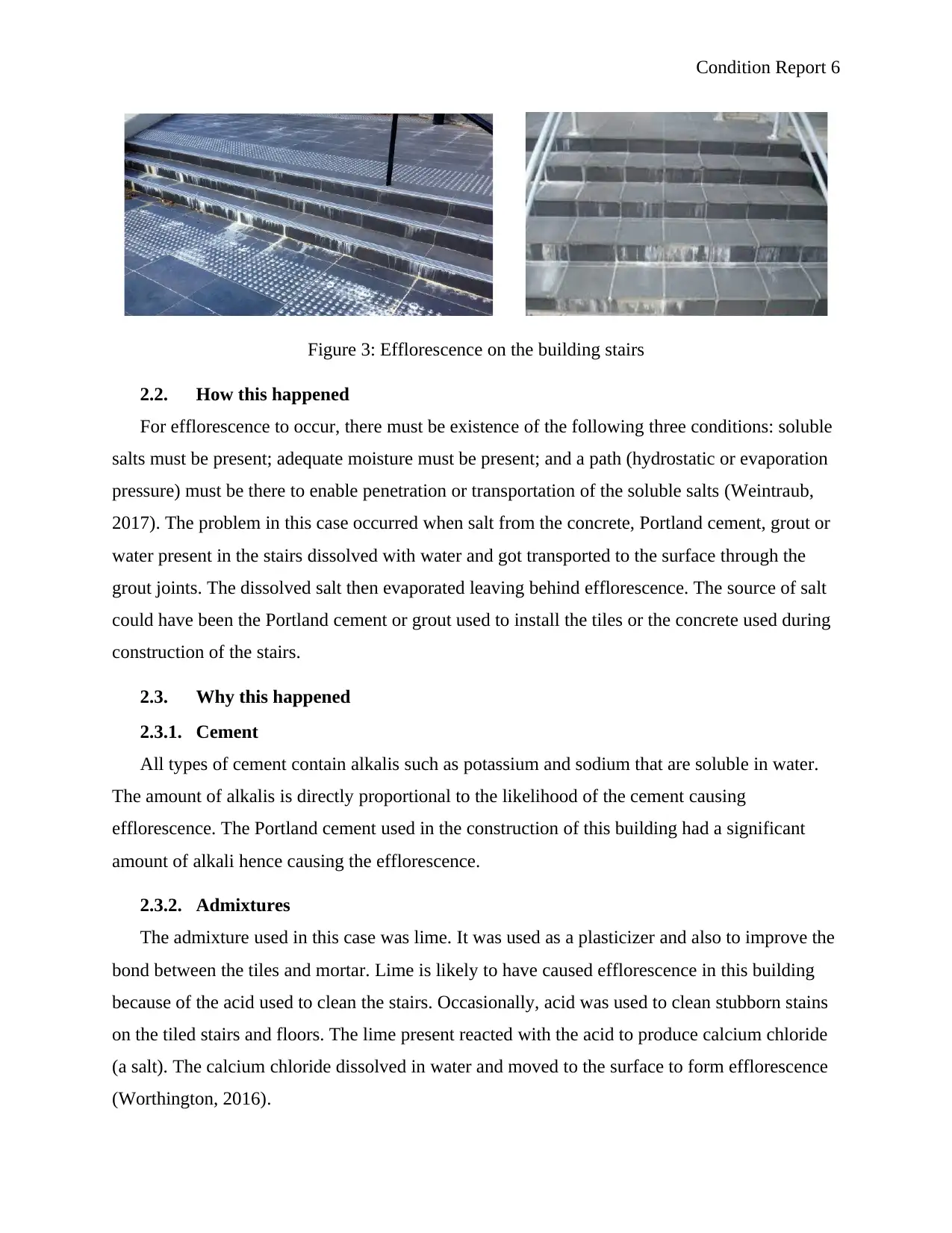
Condition Report 6
Figure 3: Efflorescence on the building stairs
2.2. How this happened
For efflorescence to occur, there must be existence of the following three conditions: soluble
salts must be present; adequate moisture must be present; and a path (hydrostatic or evaporation
pressure) must be there to enable penetration or transportation of the soluble salts (Weintraub,
2017). The problem in this case occurred when salt from the concrete, Portland cement, grout or
water present in the stairs dissolved with water and got transported to the surface through the
grout joints. The dissolved salt then evaporated leaving behind efflorescence. The source of salt
could have been the Portland cement or grout used to install the tiles or the concrete used during
construction of the stairs.
2.3. Why this happened
2.3.1. Cement
All types of cement contain alkalis such as potassium and sodium that are soluble in water.
The amount of alkalis is directly proportional to the likelihood of the cement causing
efflorescence. The Portland cement used in the construction of this building had a significant
amount of alkali hence causing the efflorescence.
2.3.2. Admixtures
The admixture used in this case was lime. It was used as a plasticizer and also to improve the
bond between the tiles and mortar. Lime is likely to have caused efflorescence in this building
because of the acid used to clean the stairs. Occasionally, acid was used to clean stubborn stains
on the tiled stairs and floors. The lime present reacted with the acid to produce calcium chloride
(a salt). The calcium chloride dissolved in water and moved to the surface to form efflorescence
(Worthington, 2016).
Figure 3: Efflorescence on the building stairs
2.2. How this happened
For efflorescence to occur, there must be existence of the following three conditions: soluble
salts must be present; adequate moisture must be present; and a path (hydrostatic or evaporation
pressure) must be there to enable penetration or transportation of the soluble salts (Weintraub,
2017). The problem in this case occurred when salt from the concrete, Portland cement, grout or
water present in the stairs dissolved with water and got transported to the surface through the
grout joints. The dissolved salt then evaporated leaving behind efflorescence. The source of salt
could have been the Portland cement or grout used to install the tiles or the concrete used during
construction of the stairs.
2.3. Why this happened
2.3.1. Cement
All types of cement contain alkalis such as potassium and sodium that are soluble in water.
The amount of alkalis is directly proportional to the likelihood of the cement causing
efflorescence. The Portland cement used in the construction of this building had a significant
amount of alkali hence causing the efflorescence.
2.3.2. Admixtures
The admixture used in this case was lime. It was used as a plasticizer and also to improve the
bond between the tiles and mortar. Lime is likely to have caused efflorescence in this building
because of the acid used to clean the stairs. Occasionally, acid was used to clean stubborn stains
on the tiled stairs and floors. The lime present reacted with the acid to produce calcium chloride
(a salt). The calcium chloride dissolved in water and moved to the surface to form efflorescence
(Worthington, 2016).
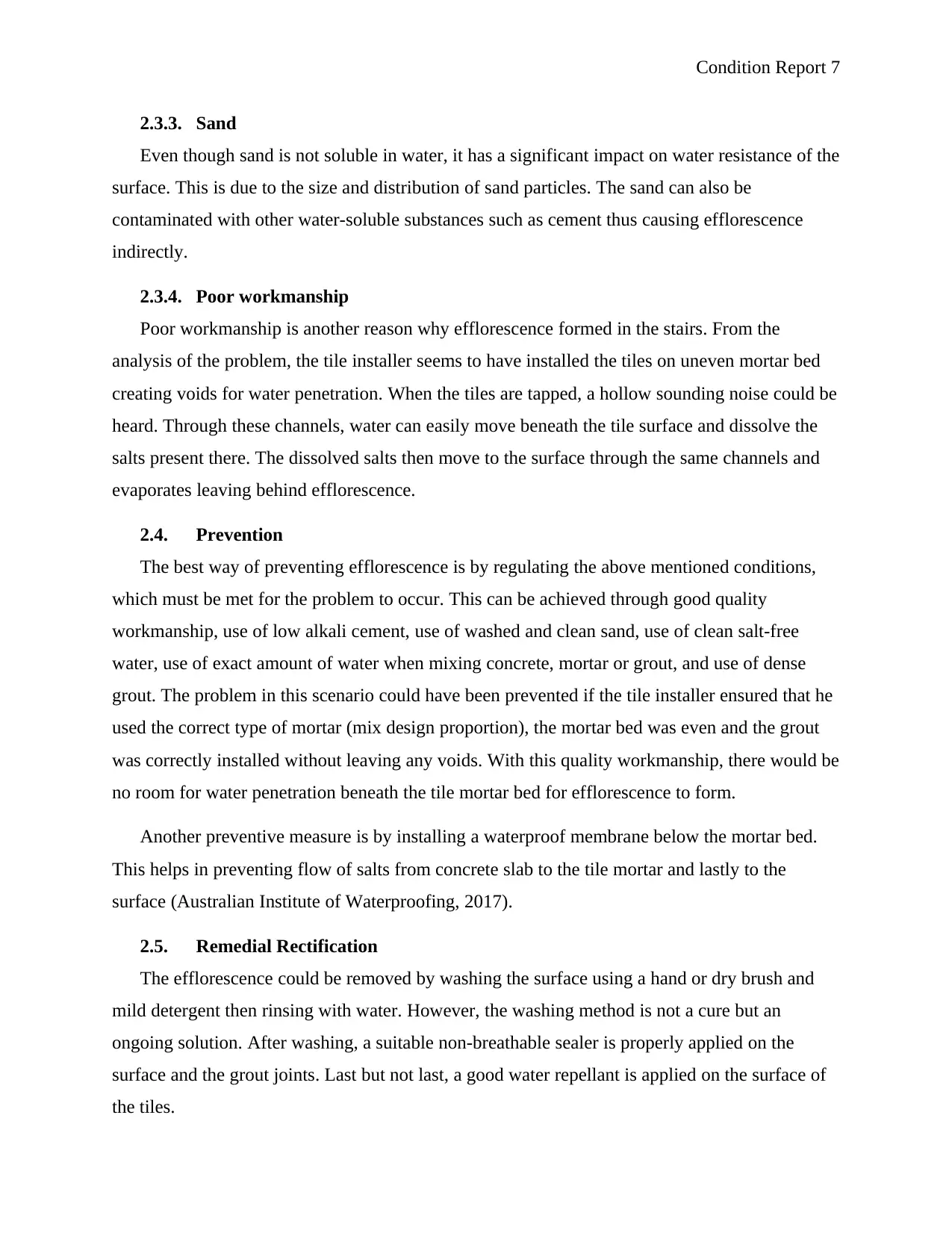
Condition Report 7
2.3.3. Sand
Even though sand is not soluble in water, it has a significant impact on water resistance of the
surface. This is due to the size and distribution of sand particles. The sand can also be
contaminated with other water-soluble substances such as cement thus causing efflorescence
indirectly.
2.3.4. Poor workmanship
Poor workmanship is another reason why efflorescence formed in the stairs. From the
analysis of the problem, the tile installer seems to have installed the tiles on uneven mortar bed
creating voids for water penetration. When the tiles are tapped, a hollow sounding noise could be
heard. Through these channels, water can easily move beneath the tile surface and dissolve the
salts present there. The dissolved salts then move to the surface through the same channels and
evaporates leaving behind efflorescence.
2.4. Prevention
The best way of preventing efflorescence is by regulating the above mentioned conditions,
which must be met for the problem to occur. This can be achieved through good quality
workmanship, use of low alkali cement, use of washed and clean sand, use of clean salt-free
water, use of exact amount of water when mixing concrete, mortar or grout, and use of dense
grout. The problem in this scenario could have been prevented if the tile installer ensured that he
used the correct type of mortar (mix design proportion), the mortar bed was even and the grout
was correctly installed without leaving any voids. With this quality workmanship, there would be
no room for water penetration beneath the tile mortar bed for efflorescence to form.
Another preventive measure is by installing a waterproof membrane below the mortar bed.
This helps in preventing flow of salts from concrete slab to the tile mortar and lastly to the
surface (Australian Institute of Waterproofing, 2017).
2.5. Remedial Rectification
The efflorescence could be removed by washing the surface using a hand or dry brush and
mild detergent then rinsing with water. However, the washing method is not a cure but an
ongoing solution. After washing, a suitable non-breathable sealer is properly applied on the
surface and the grout joints. Last but not last, a good water repellant is applied on the surface of
the tiles.
2.3.3. Sand
Even though sand is not soluble in water, it has a significant impact on water resistance of the
surface. This is due to the size and distribution of sand particles. The sand can also be
contaminated with other water-soluble substances such as cement thus causing efflorescence
indirectly.
2.3.4. Poor workmanship
Poor workmanship is another reason why efflorescence formed in the stairs. From the
analysis of the problem, the tile installer seems to have installed the tiles on uneven mortar bed
creating voids for water penetration. When the tiles are tapped, a hollow sounding noise could be
heard. Through these channels, water can easily move beneath the tile surface and dissolve the
salts present there. The dissolved salts then move to the surface through the same channels and
evaporates leaving behind efflorescence.
2.4. Prevention
The best way of preventing efflorescence is by regulating the above mentioned conditions,
which must be met for the problem to occur. This can be achieved through good quality
workmanship, use of low alkali cement, use of washed and clean sand, use of clean salt-free
water, use of exact amount of water when mixing concrete, mortar or grout, and use of dense
grout. The problem in this scenario could have been prevented if the tile installer ensured that he
used the correct type of mortar (mix design proportion), the mortar bed was even and the grout
was correctly installed without leaving any voids. With this quality workmanship, there would be
no room for water penetration beneath the tile mortar bed for efflorescence to form.
Another preventive measure is by installing a waterproof membrane below the mortar bed.
This helps in preventing flow of salts from concrete slab to the tile mortar and lastly to the
surface (Australian Institute of Waterproofing, 2017).
2.5. Remedial Rectification
The efflorescence could be removed by washing the surface using a hand or dry brush and
mild detergent then rinsing with water. However, the washing method is not a cure but an
ongoing solution. After washing, a suitable non-breathable sealer is properly applied on the
surface and the grout joints. Last but not last, a good water repellant is applied on the surface of
the tiles.
Paraphrase This Document
Need a fresh take? Get an instant paraphrase of this document with our AI Paraphraser
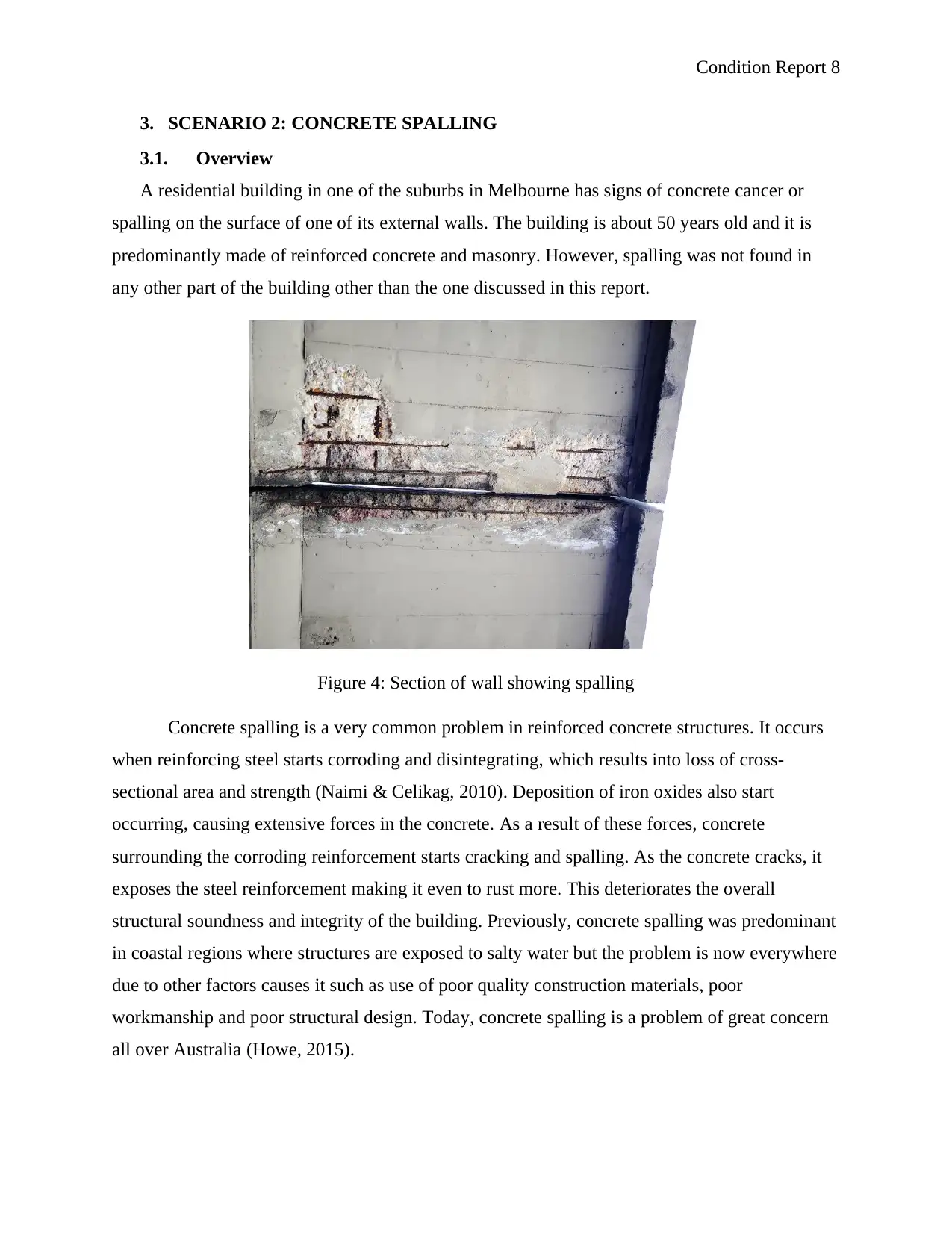
Condition Report 8
3. SCENARIO 2: CONCRETE SPALLING
3.1. Overview
A residential building in one of the suburbs in Melbourne has signs of concrete cancer or
spalling on the surface of one of its external walls. The building is about 50 years old and it is
predominantly made of reinforced concrete and masonry. However, spalling was not found in
any other part of the building other than the one discussed in this report.
Figure 4: Section of wall showing spalling
Concrete spalling is a very common problem in reinforced concrete structures. It occurs
when reinforcing steel starts corroding and disintegrating, which results into loss of cross-
sectional area and strength (Naimi & Celikag, 2010). Deposition of iron oxides also start
occurring, causing extensive forces in the concrete. As a result of these forces, concrete
surrounding the corroding reinforcement starts cracking and spalling. As the concrete cracks, it
exposes the steel reinforcement making it even to rust more. This deteriorates the overall
structural soundness and integrity of the building. Previously, concrete spalling was predominant
in coastal regions where structures are exposed to salty water but the problem is now everywhere
due to other factors causes it such as use of poor quality construction materials, poor
workmanship and poor structural design. Today, concrete spalling is a problem of great concern
all over Australia (Howe, 2015).
3. SCENARIO 2: CONCRETE SPALLING
3.1. Overview
A residential building in one of the suburbs in Melbourne has signs of concrete cancer or
spalling on the surface of one of its external walls. The building is about 50 years old and it is
predominantly made of reinforced concrete and masonry. However, spalling was not found in
any other part of the building other than the one discussed in this report.
Figure 4: Section of wall showing spalling
Concrete spalling is a very common problem in reinforced concrete structures. It occurs
when reinforcing steel starts corroding and disintegrating, which results into loss of cross-
sectional area and strength (Naimi & Celikag, 2010). Deposition of iron oxides also start
occurring, causing extensive forces in the concrete. As a result of these forces, concrete
surrounding the corroding reinforcement starts cracking and spalling. As the concrete cracks, it
exposes the steel reinforcement making it even to rust more. This deteriorates the overall
structural soundness and integrity of the building. Previously, concrete spalling was predominant
in coastal regions where structures are exposed to salty water but the problem is now everywhere
due to other factors causes it such as use of poor quality construction materials, poor
workmanship and poor structural design. Today, concrete spalling is a problem of great concern
all over Australia (Howe, 2015).
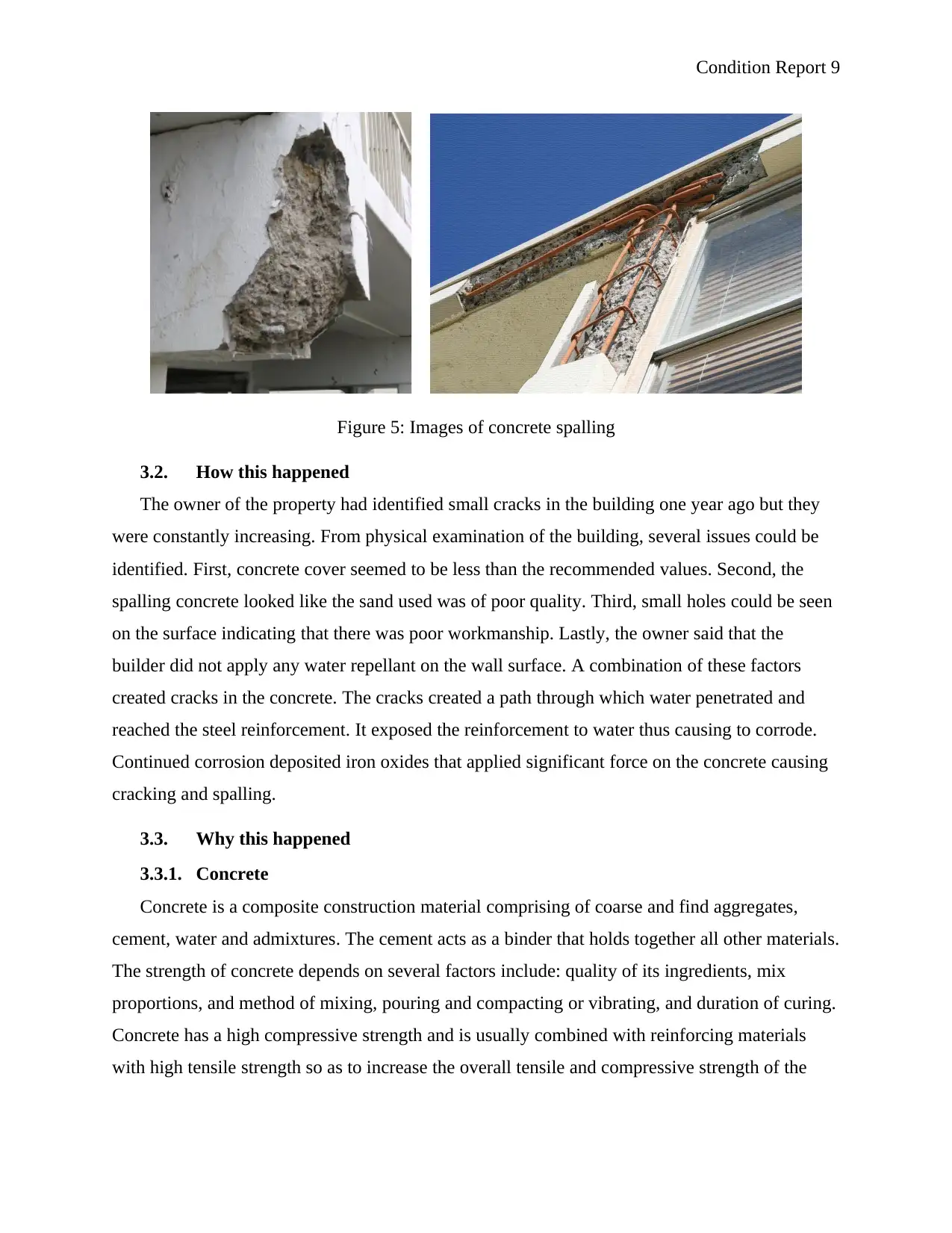
Condition Report 9
Figure 5: Images of concrete spalling
3.2. How this happened
The owner of the property had identified small cracks in the building one year ago but they
were constantly increasing. From physical examination of the building, several issues could be
identified. First, concrete cover seemed to be less than the recommended values. Second, the
spalling concrete looked like the sand used was of poor quality. Third, small holes could be seen
on the surface indicating that there was poor workmanship. Lastly, the owner said that the
builder did not apply any water repellant on the wall surface. A combination of these factors
created cracks in the concrete. The cracks created a path through which water penetrated and
reached the steel reinforcement. It exposed the reinforcement to water thus causing to corrode.
Continued corrosion deposited iron oxides that applied significant force on the concrete causing
cracking and spalling.
3.3. Why this happened
3.3.1. Concrete
Concrete is a composite construction material comprising of coarse and find aggregates,
cement, water and admixtures. The cement acts as a binder that holds together all other materials.
The strength of concrete depends on several factors include: quality of its ingredients, mix
proportions, and method of mixing, pouring and compacting or vibrating, and duration of curing.
Concrete has a high compressive strength and is usually combined with reinforcing materials
with high tensile strength so as to increase the overall tensile and compressive strength of the
Figure 5: Images of concrete spalling
3.2. How this happened
The owner of the property had identified small cracks in the building one year ago but they
were constantly increasing. From physical examination of the building, several issues could be
identified. First, concrete cover seemed to be less than the recommended values. Second, the
spalling concrete looked like the sand used was of poor quality. Third, small holes could be seen
on the surface indicating that there was poor workmanship. Lastly, the owner said that the
builder did not apply any water repellant on the wall surface. A combination of these factors
created cracks in the concrete. The cracks created a path through which water penetrated and
reached the steel reinforcement. It exposed the reinforcement to water thus causing to corrode.
Continued corrosion deposited iron oxides that applied significant force on the concrete causing
cracking and spalling.
3.3. Why this happened
3.3.1. Concrete
Concrete is a composite construction material comprising of coarse and find aggregates,
cement, water and admixtures. The cement acts as a binder that holds together all other materials.
The strength of concrete depends on several factors include: quality of its ingredients, mix
proportions, and method of mixing, pouring and compacting or vibrating, and duration of curing.
Concrete has a high compressive strength and is usually combined with reinforcing materials
with high tensile strength so as to increase the overall tensile and compressive strength of the
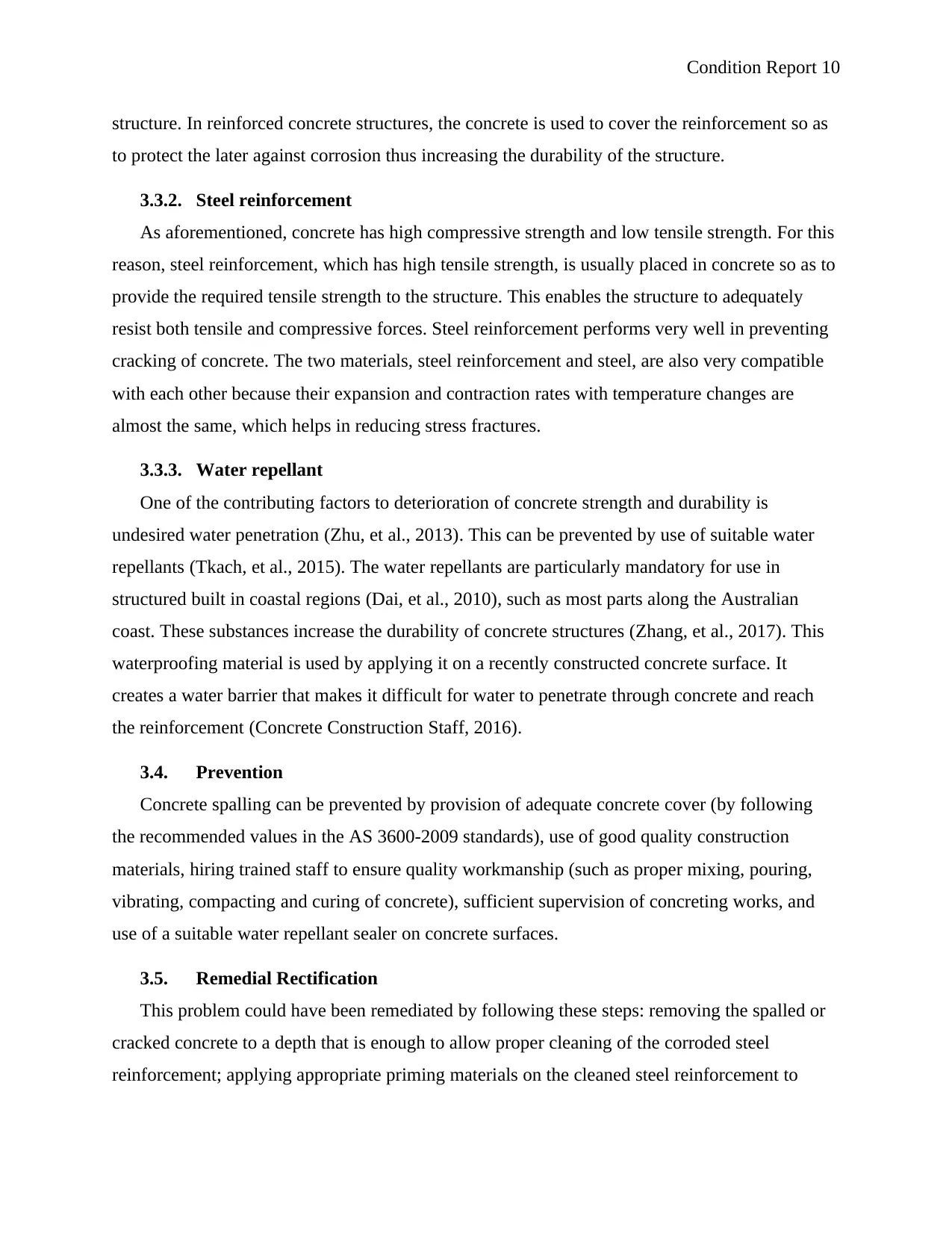
Condition Report 10
structure. In reinforced concrete structures, the concrete is used to cover the reinforcement so as
to protect the later against corrosion thus increasing the durability of the structure.
3.3.2. Steel reinforcement
As aforementioned, concrete has high compressive strength and low tensile strength. For this
reason, steel reinforcement, which has high tensile strength, is usually placed in concrete so as to
provide the required tensile strength to the structure. This enables the structure to adequately
resist both tensile and compressive forces. Steel reinforcement performs very well in preventing
cracking of concrete. The two materials, steel reinforcement and steel, are also very compatible
with each other because their expansion and contraction rates with temperature changes are
almost the same, which helps in reducing stress fractures.
3.3.3. Water repellant
One of the contributing factors to deterioration of concrete strength and durability is
undesired water penetration (Zhu, et al., 2013). This can be prevented by use of suitable water
repellants (Tkach, et al., 2015). The water repellants are particularly mandatory for use in
structured built in coastal regions (Dai, et al., 2010), such as most parts along the Australian
coast. These substances increase the durability of concrete structures (Zhang, et al., 2017). This
waterproofing material is used by applying it on a recently constructed concrete surface. It
creates a water barrier that makes it difficult for water to penetrate through concrete and reach
the reinforcement (Concrete Construction Staff, 2016).
3.4. Prevention
Concrete spalling can be prevented by provision of adequate concrete cover (by following
the recommended values in the AS 3600-2009 standards), use of good quality construction
materials, hiring trained staff to ensure quality workmanship (such as proper mixing, pouring,
vibrating, compacting and curing of concrete), sufficient supervision of concreting works, and
use of a suitable water repellant sealer on concrete surfaces.
3.5. Remedial Rectification
This problem could have been remediated by following these steps: removing the spalled or
cracked concrete to a depth that is enough to allow proper cleaning of the corroded steel
reinforcement; applying appropriate priming materials on the cleaned steel reinforcement to
structure. In reinforced concrete structures, the concrete is used to cover the reinforcement so as
to protect the later against corrosion thus increasing the durability of the structure.
3.3.2. Steel reinforcement
As aforementioned, concrete has high compressive strength and low tensile strength. For this
reason, steel reinforcement, which has high tensile strength, is usually placed in concrete so as to
provide the required tensile strength to the structure. This enables the structure to adequately
resist both tensile and compressive forces. Steel reinforcement performs very well in preventing
cracking of concrete. The two materials, steel reinforcement and steel, are also very compatible
with each other because their expansion and contraction rates with temperature changes are
almost the same, which helps in reducing stress fractures.
3.3.3. Water repellant
One of the contributing factors to deterioration of concrete strength and durability is
undesired water penetration (Zhu, et al., 2013). This can be prevented by use of suitable water
repellants (Tkach, et al., 2015). The water repellants are particularly mandatory for use in
structured built in coastal regions (Dai, et al., 2010), such as most parts along the Australian
coast. These substances increase the durability of concrete structures (Zhang, et al., 2017). This
waterproofing material is used by applying it on a recently constructed concrete surface. It
creates a water barrier that makes it difficult for water to penetrate through concrete and reach
the reinforcement (Concrete Construction Staff, 2016).
3.4. Prevention
Concrete spalling can be prevented by provision of adequate concrete cover (by following
the recommended values in the AS 3600-2009 standards), use of good quality construction
materials, hiring trained staff to ensure quality workmanship (such as proper mixing, pouring,
vibrating, compacting and curing of concrete), sufficient supervision of concreting works, and
use of a suitable water repellant sealer on concrete surfaces.
3.5. Remedial Rectification
This problem could have been remediated by following these steps: removing the spalled or
cracked concrete to a depth that is enough to allow proper cleaning of the corroded steel
reinforcement; applying appropriate priming materials on the cleaned steel reinforcement to
Secure Best Marks with AI Grader
Need help grading? Try our AI Grader for instant feedback on your assignments.
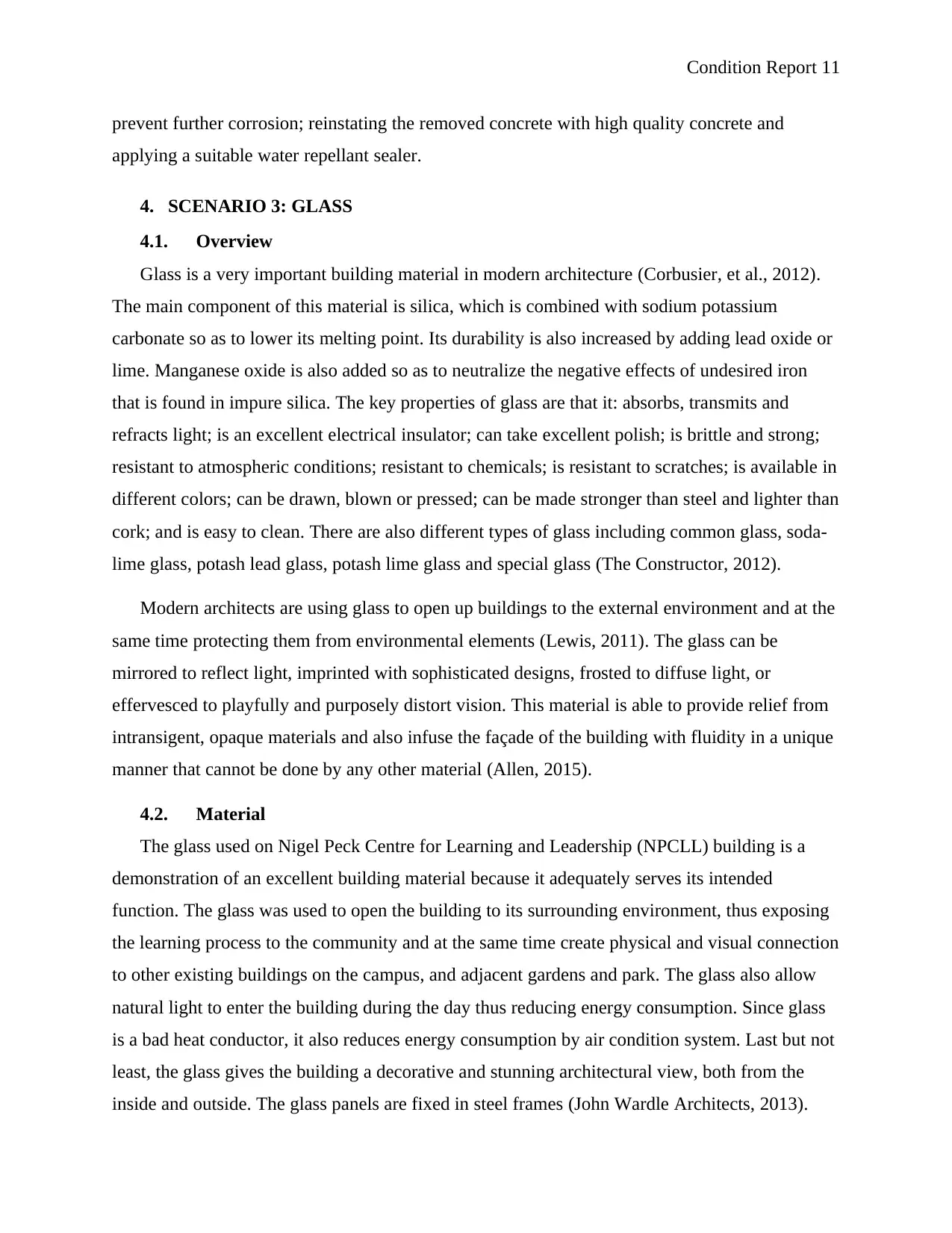
Condition Report 11
prevent further corrosion; reinstating the removed concrete with high quality concrete and
applying a suitable water repellant sealer.
4. SCENARIO 3: GLASS
4.1. Overview
Glass is a very important building material in modern architecture (Corbusier, et al., 2012).
The main component of this material is silica, which is combined with sodium potassium
carbonate so as to lower its melting point. Its durability is also increased by adding lead oxide or
lime. Manganese oxide is also added so as to neutralize the negative effects of undesired iron
that is found in impure silica. The key properties of glass are that it: absorbs, transmits and
refracts light; is an excellent electrical insulator; can take excellent polish; is brittle and strong;
resistant to atmospheric conditions; resistant to chemicals; is resistant to scratches; is available in
different colors; can be drawn, blown or pressed; can be made stronger than steel and lighter than
cork; and is easy to clean. There are also different types of glass including common glass, soda-
lime glass, potash lead glass, potash lime glass and special glass (The Constructor, 2012).
Modern architects are using glass to open up buildings to the external environment and at the
same time protecting them from environmental elements (Lewis, 2011). The glass can be
mirrored to reflect light, imprinted with sophisticated designs, frosted to diffuse light, or
effervesced to playfully and purposely distort vision. This material is able to provide relief from
intransigent, opaque materials and also infuse the façade of the building with fluidity in a unique
manner that cannot be done by any other material (Allen, 2015).
4.2. Material
The glass used on Nigel Peck Centre for Learning and Leadership (NPCLL) building is a
demonstration of an excellent building material because it adequately serves its intended
function. The glass was used to open the building to its surrounding environment, thus exposing
the learning process to the community and at the same time create physical and visual connection
to other existing buildings on the campus, and adjacent gardens and park. The glass also allow
natural light to enter the building during the day thus reducing energy consumption. Since glass
is a bad heat conductor, it also reduces energy consumption by air condition system. Last but not
least, the glass gives the building a decorative and stunning architectural view, both from the
inside and outside. The glass panels are fixed in steel frames (John Wardle Architects, 2013).
prevent further corrosion; reinstating the removed concrete with high quality concrete and
applying a suitable water repellant sealer.
4. SCENARIO 3: GLASS
4.1. Overview
Glass is a very important building material in modern architecture (Corbusier, et al., 2012).
The main component of this material is silica, which is combined with sodium potassium
carbonate so as to lower its melting point. Its durability is also increased by adding lead oxide or
lime. Manganese oxide is also added so as to neutralize the negative effects of undesired iron
that is found in impure silica. The key properties of glass are that it: absorbs, transmits and
refracts light; is an excellent electrical insulator; can take excellent polish; is brittle and strong;
resistant to atmospheric conditions; resistant to chemicals; is resistant to scratches; is available in
different colors; can be drawn, blown or pressed; can be made stronger than steel and lighter than
cork; and is easy to clean. There are also different types of glass including common glass, soda-
lime glass, potash lead glass, potash lime glass and special glass (The Constructor, 2012).
Modern architects are using glass to open up buildings to the external environment and at the
same time protecting them from environmental elements (Lewis, 2011). The glass can be
mirrored to reflect light, imprinted with sophisticated designs, frosted to diffuse light, or
effervesced to playfully and purposely distort vision. This material is able to provide relief from
intransigent, opaque materials and also infuse the façade of the building with fluidity in a unique
manner that cannot be done by any other material (Allen, 2015).
4.2. Material
The glass used on Nigel Peck Centre for Learning and Leadership (NPCLL) building is a
demonstration of an excellent building material because it adequately serves its intended
function. The glass was used to open the building to its surrounding environment, thus exposing
the learning process to the community and at the same time create physical and visual connection
to other existing buildings on the campus, and adjacent gardens and park. The glass also allow
natural light to enter the building during the day thus reducing energy consumption. Since glass
is a bad heat conductor, it also reduces energy consumption by air condition system. Last but not
least, the glass gives the building a decorative and stunning architectural view, both from the
inside and outside. The glass panels are fixed in steel frames (John Wardle Architects, 2013).
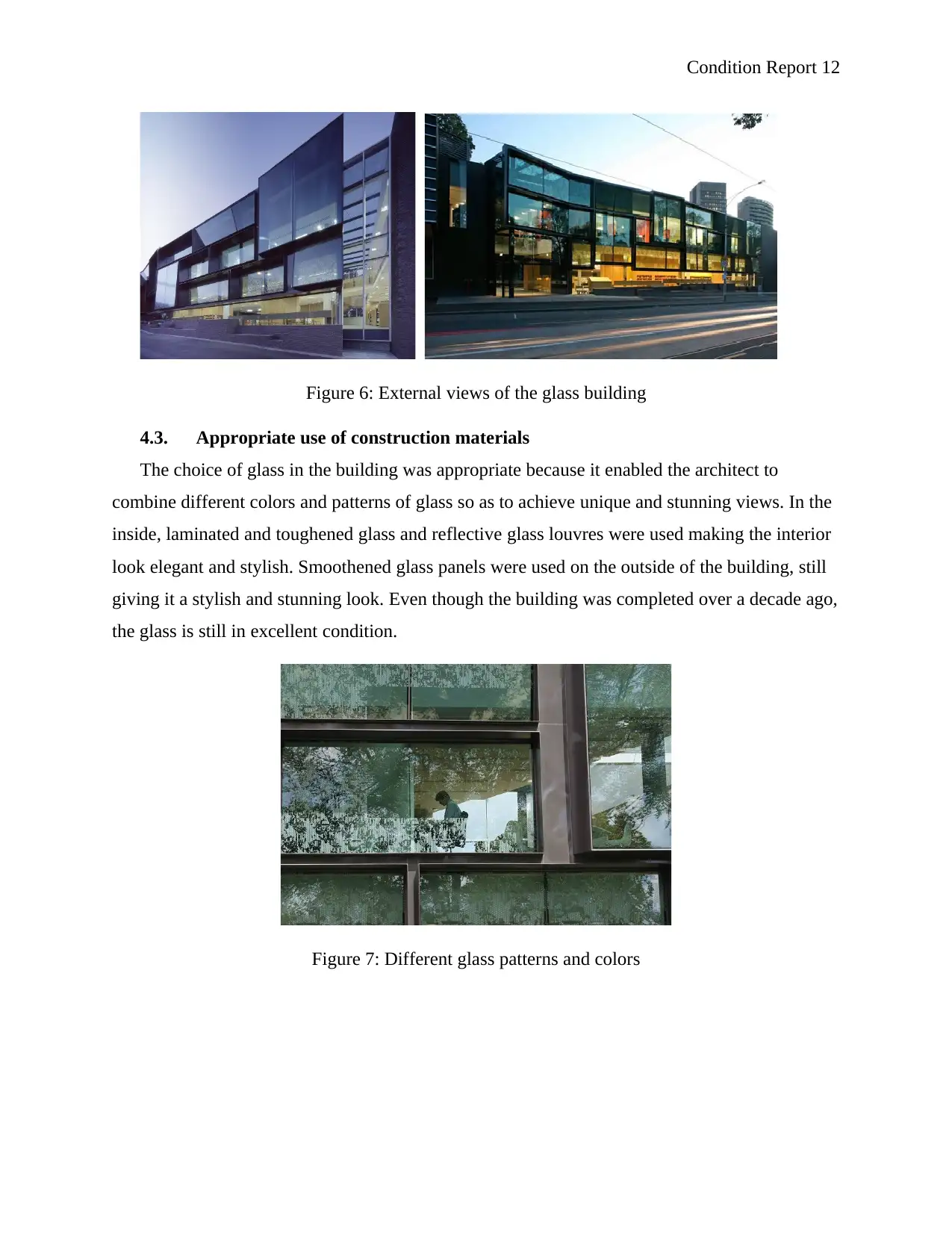
Condition Report 12
Figure 6: External views of the glass building
4.3. Appropriate use of construction materials
The choice of glass in the building was appropriate because it enabled the architect to
combine different colors and patterns of glass so as to achieve unique and stunning views. In the
inside, laminated and toughened glass and reflective glass louvres were used making the interior
look elegant and stylish. Smoothened glass panels were used on the outside of the building, still
giving it a stylish and stunning look. Even though the building was completed over a decade ago,
the glass is still in excellent condition.
Figure 7: Different glass patterns and colors
Figure 6: External views of the glass building
4.3. Appropriate use of construction materials
The choice of glass in the building was appropriate because it enabled the architect to
combine different colors and patterns of glass so as to achieve unique and stunning views. In the
inside, laminated and toughened glass and reflective glass louvres were used making the interior
look elegant and stylish. Smoothened glass panels were used on the outside of the building, still
giving it a stylish and stunning look. Even though the building was completed over a decade ago,
the glass is still in excellent condition.
Figure 7: Different glass patterns and colors
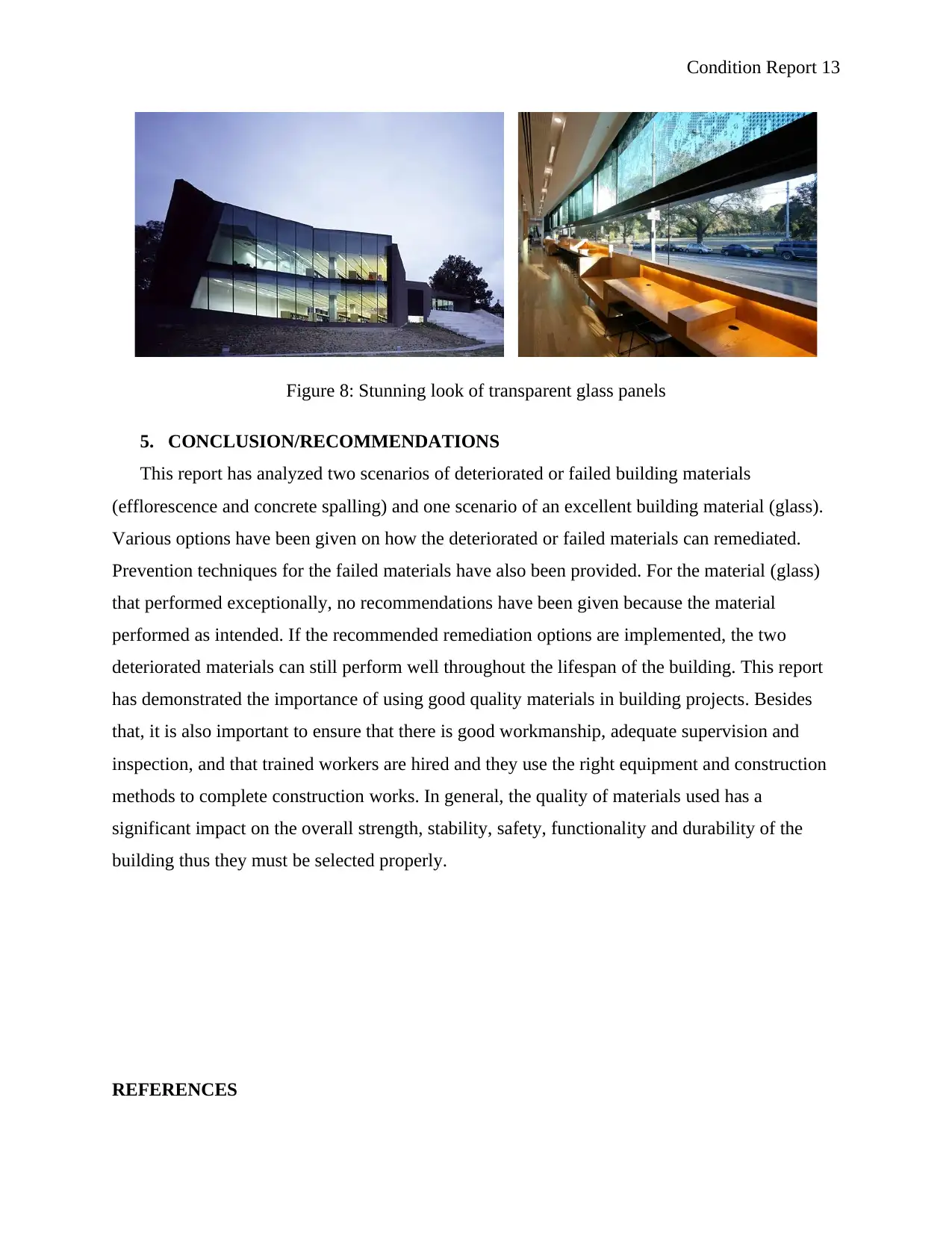
Condition Report 13
Figure 8: Stunning look of transparent glass panels
5. CONCLUSION/RECOMMENDATIONS
This report has analyzed two scenarios of deteriorated or failed building materials
(efflorescence and concrete spalling) and one scenario of an excellent building material (glass).
Various options have been given on how the deteriorated or failed materials can remediated.
Prevention techniques for the failed materials have also been provided. For the material (glass)
that performed exceptionally, no recommendations have been given because the material
performed as intended. If the recommended remediation options are implemented, the two
deteriorated materials can still perform well throughout the lifespan of the building. This report
has demonstrated the importance of using good quality materials in building projects. Besides
that, it is also important to ensure that there is good workmanship, adequate supervision and
inspection, and that trained workers are hired and they use the right equipment and construction
methods to complete construction works. In general, the quality of materials used has a
significant impact on the overall strength, stability, safety, functionality and durability of the
building thus they must be selected properly.
REFERENCES
Figure 8: Stunning look of transparent glass panels
5. CONCLUSION/RECOMMENDATIONS
This report has analyzed two scenarios of deteriorated or failed building materials
(efflorescence and concrete spalling) and one scenario of an excellent building material (glass).
Various options have been given on how the deteriorated or failed materials can remediated.
Prevention techniques for the failed materials have also been provided. For the material (glass)
that performed exceptionally, no recommendations have been given because the material
performed as intended. If the recommended remediation options are implemented, the two
deteriorated materials can still perform well throughout the lifespan of the building. This report
has demonstrated the importance of using good quality materials in building projects. Besides
that, it is also important to ensure that there is good workmanship, adequate supervision and
inspection, and that trained workers are hired and they use the right equipment and construction
methods to complete construction works. In general, the quality of materials used has a
significant impact on the overall strength, stability, safety, functionality and durability of the
building thus they must be selected properly.
REFERENCES
Paraphrase This Document
Need a fresh take? Get an instant paraphrase of this document with our AI Paraphraser
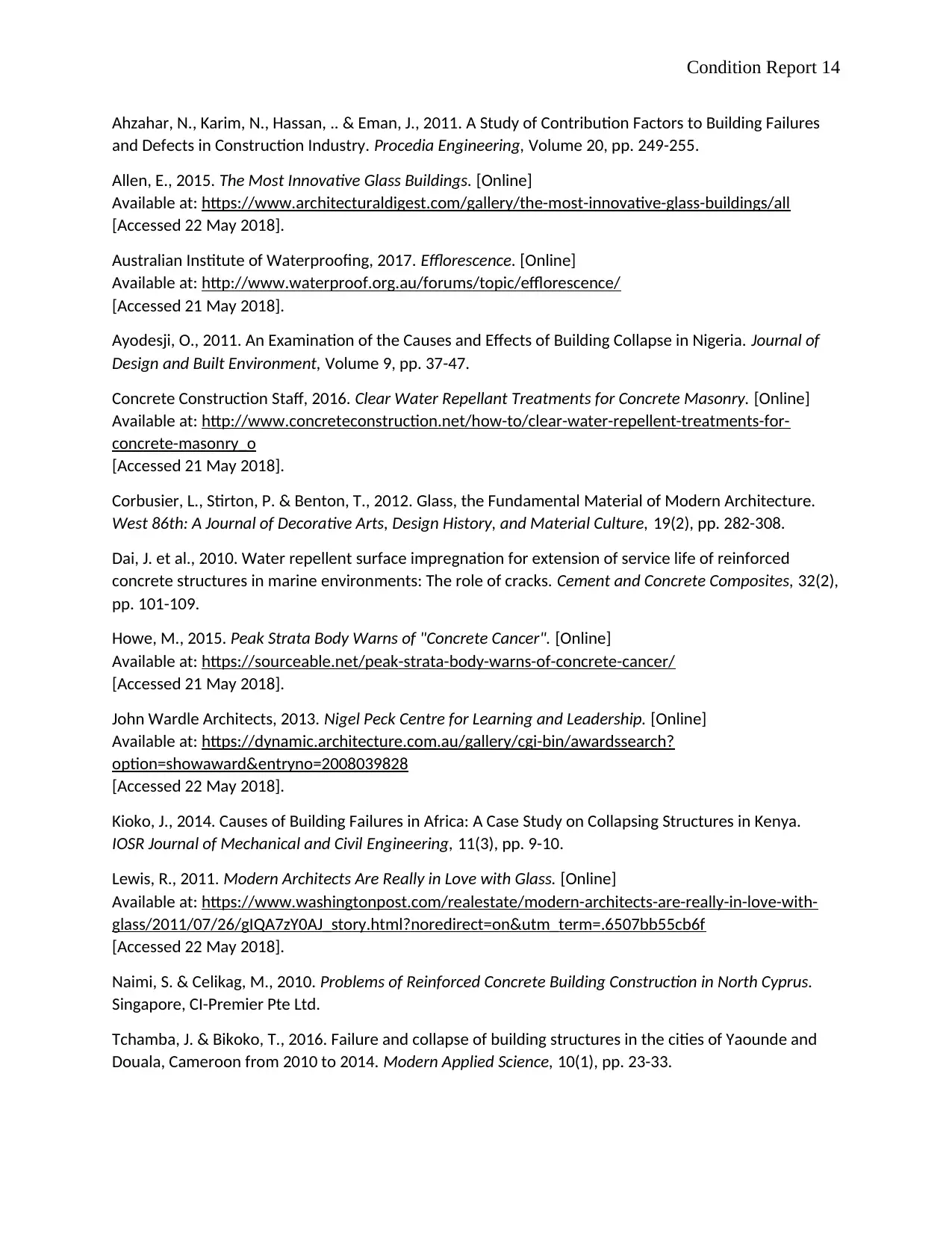
Condition Report 14
Ahzahar, N., Karim, N., Hassan, .. & Eman, J., 2011. A Study of Contribution Factors to Building Failures
and Defects in Construction Industry. Procedia Engineering, Volume 20, pp. 249-255.
Allen, E., 2015. The Most Innovative Glass Buildings. [Online]
Available at: https://www.architecturaldigest.com/gallery/the-most-innovative-glass-buildings/all
[Accessed 22 May 2018].
Australian Institute of Waterproofing, 2017. Efflorescence. [Online]
Available at: http://www.waterproof.org.au/forums/topic/efflorescence/
[Accessed 21 May 2018].
Ayodesji, O., 2011. An Examination of the Causes and Effects of Building Collapse in Nigeria. Journal of
Design and Built Environment, Volume 9, pp. 37-47.
Concrete Construction Staff, 2016. Clear Water Repellant Treatments for Concrete Masonry. [Online]
Available at: http://www.concreteconstruction.net/how-to/clear-water-repellent-treatments-for-
concrete-masonry_o
[Accessed 21 May 2018].
Corbusier, L., Stirton, P. & Benton, T., 2012. Glass, the Fundamental Material of Modern Architecture.
West 86th: A Journal of Decorative Arts, Design History, and Material Culture, 19(2), pp. 282-308.
Dai, J. et al., 2010. Water repellent surface impregnation for extension of service life of reinforced
concrete structures in marine environments: The role of cracks. Cement and Concrete Composites, 32(2),
pp. 101-109.
Howe, M., 2015. Peak Strata Body Warns of "Concrete Cancer". [Online]
Available at: https://sourceable.net/peak-strata-body-warns-of-concrete-cancer/
[Accessed 21 May 2018].
John Wardle Architects, 2013. Nigel Peck Centre for Learning and Leadership. [Online]
Available at: https://dynamic.architecture.com.au/gallery/cgi-bin/awardssearch?
option=showaward&entryno=2008039828
[Accessed 22 May 2018].
Kioko, J., 2014. Causes of Building Failures in Africa: A Case Study on Collapsing Structures in Kenya.
IOSR Journal of Mechanical and Civil Engineering, 11(3), pp. 9-10.
Lewis, R., 2011. Modern Architects Are Really in Love with Glass. [Online]
Available at: https://www.washingtonpost.com/realestate/modern-architects-are-really-in-love-with-
glass/2011/07/26/gIQA7zY0AJ_story.html?noredirect=on&utm_term=.6507bb55cb6f
[Accessed 22 May 2018].
Naimi, S. & Celikag, M., 2010. Problems of Reinforced Concrete Building Construction in North Cyprus.
Singapore, CI-Premier Pte Ltd.
Tchamba, J. & Bikoko, T., 2016. Failure and collapse of building structures in the cities of Yaounde and
Douala, Cameroon from 2010 to 2014. Modern Applied Science, 10(1), pp. 23-33.
Ahzahar, N., Karim, N., Hassan, .. & Eman, J., 2011. A Study of Contribution Factors to Building Failures
and Defects in Construction Industry. Procedia Engineering, Volume 20, pp. 249-255.
Allen, E., 2015. The Most Innovative Glass Buildings. [Online]
Available at: https://www.architecturaldigest.com/gallery/the-most-innovative-glass-buildings/all
[Accessed 22 May 2018].
Australian Institute of Waterproofing, 2017. Efflorescence. [Online]
Available at: http://www.waterproof.org.au/forums/topic/efflorescence/
[Accessed 21 May 2018].
Ayodesji, O., 2011. An Examination of the Causes and Effects of Building Collapse in Nigeria. Journal of
Design and Built Environment, Volume 9, pp. 37-47.
Concrete Construction Staff, 2016. Clear Water Repellant Treatments for Concrete Masonry. [Online]
Available at: http://www.concreteconstruction.net/how-to/clear-water-repellent-treatments-for-
concrete-masonry_o
[Accessed 21 May 2018].
Corbusier, L., Stirton, P. & Benton, T., 2012. Glass, the Fundamental Material of Modern Architecture.
West 86th: A Journal of Decorative Arts, Design History, and Material Culture, 19(2), pp. 282-308.
Dai, J. et al., 2010. Water repellent surface impregnation for extension of service life of reinforced
concrete structures in marine environments: The role of cracks. Cement and Concrete Composites, 32(2),
pp. 101-109.
Howe, M., 2015. Peak Strata Body Warns of "Concrete Cancer". [Online]
Available at: https://sourceable.net/peak-strata-body-warns-of-concrete-cancer/
[Accessed 21 May 2018].
John Wardle Architects, 2013. Nigel Peck Centre for Learning and Leadership. [Online]
Available at: https://dynamic.architecture.com.au/gallery/cgi-bin/awardssearch?
option=showaward&entryno=2008039828
[Accessed 22 May 2018].
Kioko, J., 2014. Causes of Building Failures in Africa: A Case Study on Collapsing Structures in Kenya.
IOSR Journal of Mechanical and Civil Engineering, 11(3), pp. 9-10.
Lewis, R., 2011. Modern Architects Are Really in Love with Glass. [Online]
Available at: https://www.washingtonpost.com/realestate/modern-architects-are-really-in-love-with-
glass/2011/07/26/gIQA7zY0AJ_story.html?noredirect=on&utm_term=.6507bb55cb6f
[Accessed 22 May 2018].
Naimi, S. & Celikag, M., 2010. Problems of Reinforced Concrete Building Construction in North Cyprus.
Singapore, CI-Premier Pte Ltd.
Tchamba, J. & Bikoko, T., 2016. Failure and collapse of building structures in the cities of Yaounde and
Douala, Cameroon from 2010 to 2014. Modern Applied Science, 10(1), pp. 23-33.
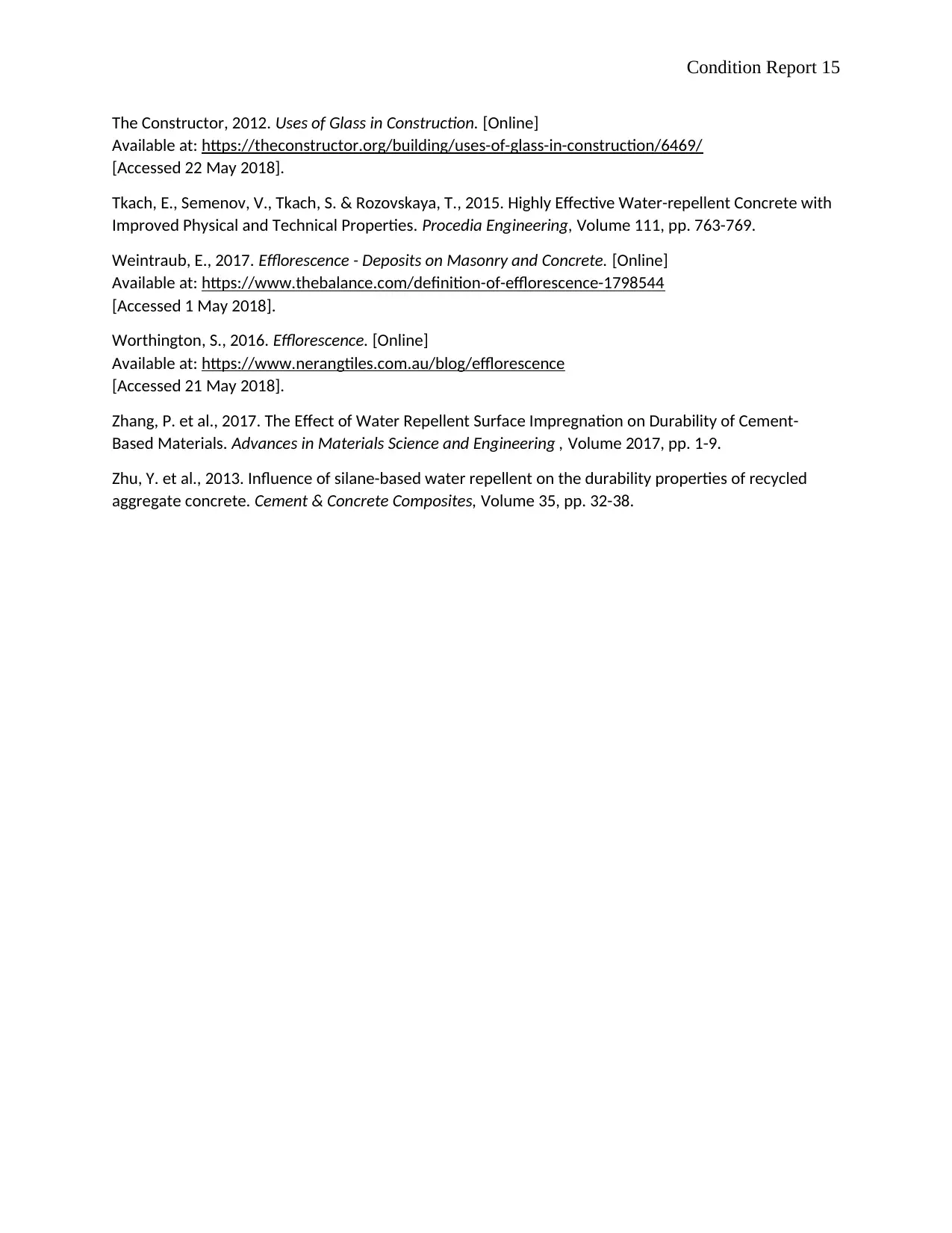
Condition Report 15
The Constructor, 2012. Uses of Glass in Construction. [Online]
Available at: https://theconstructor.org/building/uses-of-glass-in-construction/6469/
[Accessed 22 May 2018].
Tkach, E., Semenov, V., Tkach, S. & Rozovskaya, T., 2015. Highly Effective Water-repellent Concrete with
Improved Physical and Technical Properties. Procedia Engineering, Volume 111, pp. 763-769.
Weintraub, E., 2017. Efflorescence - Deposits on Masonry and Concrete. [Online]
Available at: https://www.thebalance.com/definition-of-efflorescence-1798544
[Accessed 1 May 2018].
Worthington, S., 2016. Efflorescence. [Online]
Available at: https://www.nerangtiles.com.au/blog/efflorescence
[Accessed 21 May 2018].
Zhang, P. et al., 2017. The Effect of Water Repellent Surface Impregnation on Durability of Cement-
Based Materials. Advances in Materials Science and Engineering , Volume 2017, pp. 1-9.
Zhu, Y. et al., 2013. Influence of silane-based water repellent on the durability properties of recycled
aggregate concrete. Cement & Concrete Composites, Volume 35, pp. 32-38.
The Constructor, 2012. Uses of Glass in Construction. [Online]
Available at: https://theconstructor.org/building/uses-of-glass-in-construction/6469/
[Accessed 22 May 2018].
Tkach, E., Semenov, V., Tkach, S. & Rozovskaya, T., 2015. Highly Effective Water-repellent Concrete with
Improved Physical and Technical Properties. Procedia Engineering, Volume 111, pp. 763-769.
Weintraub, E., 2017. Efflorescence - Deposits on Masonry and Concrete. [Online]
Available at: https://www.thebalance.com/definition-of-efflorescence-1798544
[Accessed 1 May 2018].
Worthington, S., 2016. Efflorescence. [Online]
Available at: https://www.nerangtiles.com.au/blog/efflorescence
[Accessed 21 May 2018].
Zhang, P. et al., 2017. The Effect of Water Repellent Surface Impregnation on Durability of Cement-
Based Materials. Advances in Materials Science and Engineering , Volume 2017, pp. 1-9.
Zhu, Y. et al., 2013. Influence of silane-based water repellent on the durability properties of recycled
aggregate concrete. Cement & Concrete Composites, Volume 35, pp. 32-38.
1 out of 15
Your All-in-One AI-Powered Toolkit for Academic Success.
+13062052269
info@desklib.com
Available 24*7 on WhatsApp / Email
![[object Object]](/_next/static/media/star-bottom.7253800d.svg)
Unlock your academic potential
© 2024 | Zucol Services PVT LTD | All rights reserved.
